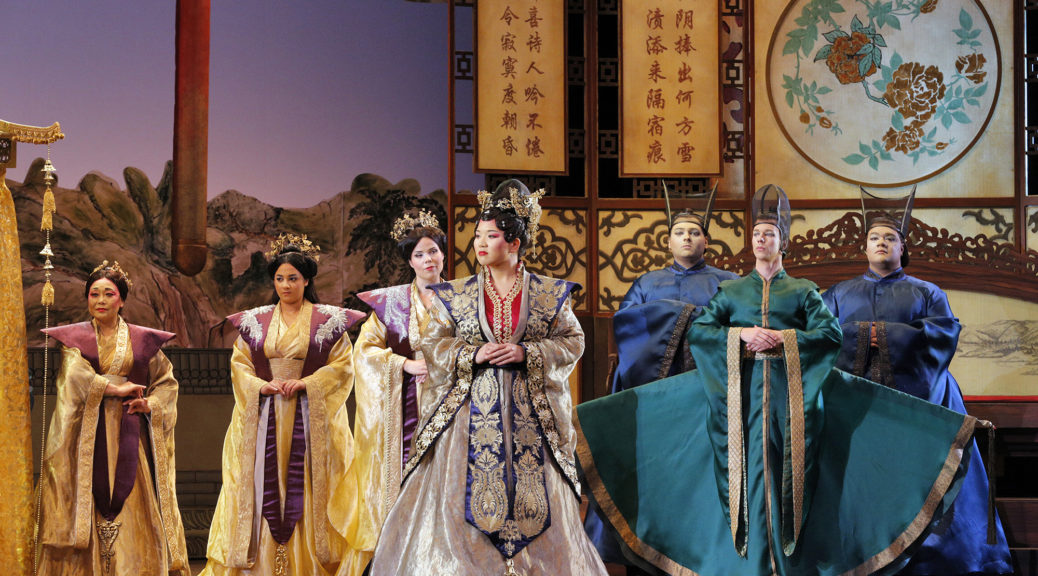
AN ARRESTING NEW AMERICAN-AND-CHINESE OPERA
With the SFO’s “Red Chamber” World Premiere
By Paul Hertelendy
artssf.com, the independent observer of San Francisco Bay Area music and dance
Week of Sept. 14-21 , 2016
Vol. 19, No. 2
The new Chinese opera-tragedy “Dream of the Red Chamber” offers high drama after a lengthy, opulent prologue, turning a classic novel into an opera that is closer to a musical feast than to consistent theater.
The emigre Chinese composer Bright Sheng has created a rich, listenable score astutely combining both western and eastern instruments, aided by David Henry Hwang’s every-day English-language libretto. After the intermission, the slow-starting opera with a Romeo-and-Juliet-like love story turns into a whirlwind of betrayal, suicide, action and reaction, ending in a “Goetterdaemmerung” conflagration scattering the principals into isolated fragments, incapable of putting all the pieces back together.
For the San Francisco Opera, which presented the world premiere Sept. 10, this piece spans the Pacific in viable fashion, headed toward its Hong Kong premiere six months hence. The story is a very thin slice out of a long epic 18th-century Chinese novel linking old-style courtly machinations with fairy-tale elements. In bridging the oceans, it introduces our audiences to a work as familiar in China as “Moby Dick” and “La Boheme” are in the US.
The lasting impression of this luxurious production is the musical eloquence, rising to the dramatic occasion, and flowing effectively for the reflective arias. The septet just before intermission is a classic achievement rarely essayed by living composers. The opera’s big flaw is visual and static, as the hohum opening act that fails to pose a dramatic turningpoint for its finale and ensuing intermission.
The fantasy-to-reality plot is compelling, as the Stone and the Flower transform into human beings and later lovers. The Stone becomes the animated tenor role of Bao Yu, the biggest part in the opera (Yijie Shi, a tenor with a tireless trumpety voice). The Flower turns into the sensitive Dai Yu, one of three notable sopranos in the female-dominated cast. A manipulative relative’s ruse separates the two and leads to the downfall of the dynastic family palace and all its inhabitants. With the pair treading the world forcibly separated and alone, the conclusion is poignant.
The work is also a critique of the old ways in China, when wealth, stature and position in the empire’s pecking order were far more important than enterprise or good character. The family member who is the Imperial Concubine—the most powerful woman of all—drops from the top to the bottom with a whim of the Emperor. Knocking the idealistic hero, the monk/narrator/author remarks wryly on “the foolish mortals lost in the world of illusions.” Reading between the lines reveals an implicit plea for another system without a central authority, such as democracy. So while this is a tale about bygone dynasties, it is also a work relevant to the 21st century.
The complex production of 11 scenes put together by designer Tim Yip and Director Stan Lai is magnificent, both in the fast-changing array of sets as well as lavish costumes. Fascinating mimes portray the transformation of Stone-and-Flower to humans in jaw-dropping fashion, while an array of women dancers porrtray the temptations of the flesh in the hero’s vivid red dream, like a Chinese counterpart to the lurid opening ballet of “Tannhaeuser.”
The opera featured a trio of excellent lyric sopranos: (Pureum Jo) in the Flower role of the beloved, Irene Roberts as the other woman Bao Chai who is pushed to marry the hero; and Karen Chia-Ling Ho as the Imperial Concubine. These are ably supplemented by the lower voices of the older generation: the Granny Jiu role (Qiulin Zhang), and Lady Wang role (Hyona Kim) which is the one villain of the piece. George Monahan conducted, responsive to both singers and musicians.
The crux of the matter is not whether this opus will be the next “Turandot” hit. It’s whether it can link two highly contrasting cultures and eras successfully. And, in that regard, “Red Chamber” succeeded in its mission.
Bright Sheng’s opera-tragedy “Dream of the Red Chamber,” world premiere production at the S.F. Opera opening Sept. 10 (through 29th). For SFO info: (415) 864-3330, or go online.
©Paul Hertelendy 2016
#
Paul Hertelendy has been covering the dance and modern-music scene in the San Francisco Bay Area with relish — and a certain amount of salsa — for years.
These critiques appearing weekly (or sometimes semi-weekly, but never weakly) will focus on dance and new musical creativity in performance, with forays into books (by authors of the region), theater and recordings by local artists as well.
#